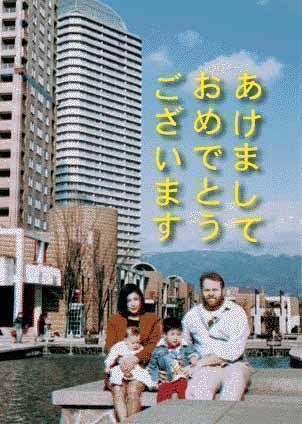(Click the people in the picture below and the Japanese characters above to hear pronunciations)
 The Japanese people send hundreds and thousands of nengajo to each other every new year. They vary from simple B&W calligraphy to color photos of the family or kids. Many are elegant works of art. The message invariably contains "Akemashite, omedetou gozaimasu!" (seen in yellow characters on the card shown here), which is the equivalent of our saying "Happy New Year!" There may also be some small but important tidbit of family news. The cards are mailed near the end of December and delivered on new year's day or shortly thereafter.
The Japanese people send hundreds and thousands of nengajo to each other every new year. They vary from simple B&W calligraphy to color photos of the family or kids. Many are elegant works of art. The message invariably contains "Akemashite, omedetou gozaimasu!" (seen in yellow characters on the card shown here), which is the equivalent of our saying "Happy New Year!" There may also be some small but important tidbit of family news. The cards are mailed near the end of December and delivered on new year's day or shortly thereafter.
Blank cards can be purchased anywhere, but official government postcards are available only at post offices for 50 yen each (about 50 cents U.S., depending on the current exchange rate). These government postcards are blank on one side (for writing your own greeting) and have a lottery number and a "new year" postage stamp printed on the address side. Sometime in the middle of January, winning numbers are announced and prizes (up to TV's) are awarded. The government never prints enough of these official lottery cards; post offices are usually sold out by the second week of December.
My in-laws receive thousands of nengajo every year. I've seen them flipping through them like oversized playing cards, pausing only to comment on a particulary beautiful or unusual design or note. My goal every year, then, is to create a nengajo that will stop the receiver in mid-shuffle.
Two years ago, I did a 3-D nengajo (above) using a technique I found in
Adobe's "Design Essentials" book. I pasted a handmade pair of
paper glasses with red/green cellophane lenses on each nengajo. The receiver
peeled off the glasses and held them to their eyes to view the 3-D effect.
Make yourself a pair and check it out.
Last year, a friend made a simple QuickTime movie of himself riding his
bicycle toward the camera, then created a flipbook using Photoshop's ability
to rasterize QuickTime filmstrips. He then pasted the flipbook onto a nengajo
with instructions in English and Japanese on how to flip the pages!
This year, I did not have enough time to do both a Japanese nengajo and
an English A4-size newsletter for the folks overseas, so I combined the
two and created an A4 "nengaletter." This nengaletter was the
foundation for my home page, which you are now reading.
For next year, I've got a really great idea. I'm going to...whoa! If you
want to see it, you'll have to bookmark me and check back on new year's
day, 1997!
By the way, our apartment is on the top floor of that silvery-looking building
in the background. Quite a place to be during an earthquake.
(Click the rightmost apartment on the top floor to see a panoramic view
from our apartment.) Mt. Rokko is in the background, and we are sitting
on the "banks" of the Rokko River, an artifical stream that runs
down the middle of our artifical Rokko
Island. That river was our only source of non-drinking water for
a month after the earthquake.